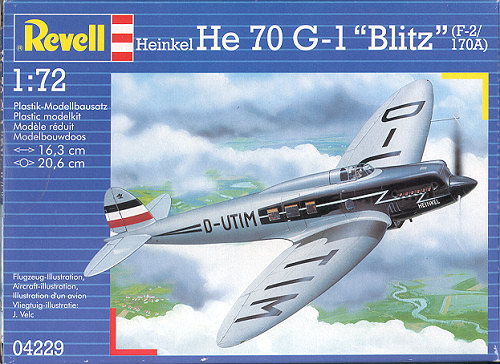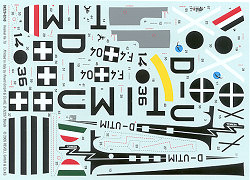
| KIT: | Revell 1/72 He-70 'Blitz' |
| KIT #: | 04229 |
| PRICE: | $7.20 from www.greatmodels.com |
| DECALS: | Three options |
| REVIEWER: | Scott Van Aken |
| NOTES: | Repackaged Matchbox kit |

| HISTORY |
The Heinkel He 70 Blitz was designed in the early 1930s to serve as a fast mailplane for Deutsche Lufthansa. Although useful, it had a relatively brief commercial career before it was replaced by types which could carry more passengers. As a combat aircraft it was a not a great success because it rapidly became outdated. Nevertheless, the He 70 was a brilliant design for its day, setting no fewer than eight world speed records by the beginning of 1933. The main characteristics of its revolutionary design were its elliptical wing, which the Günther brothers had already used in the Bäumer Sausewind sports plane before they joined Heinkel, and its small, rounded control surfaces.
The He 70 is known mainly as the direct ancestor of the famous Heinkel He 111 which used its distinctive oval wings and streamlined fuselage in a twin-engine configuration. One can also see the close similarity of the designs in the tail section and cockpit of the early He 111. The He 111, which began service with the Luftwaffe in 1936, went on to become the major bomber type in the early years of World War II.
Heinkel's pioneering design was also a model for the Heinkel He 112 fighter which competed unsuccessfully against the Messerschmitt Bf 109 to become the Luftwaffe's first monoplane fighter. The He 112 was nonetheless built in small numbers and its performance proved once again the strength of the He 70's original design. The fighter was basically a scaled down version of the He 70 and shared its all-metal construction and inverted gull-wings.
The He 70 was exported to Japan for study and inspired the Aichi D3A (Val) carrier-launched light bomber. This plane too shared the He 70's distinctive low-mounted oval wings and was only one of several collaborations between Heinkel and the Japanese aviation industry. Many also feel that the He-70's wing shape was an inspiration for the Supermarine Spitfire as there are striking similarities between the two.
While the He 70 saw only limited service in training capacities during World War II, though it did see service in the Spanish Civil War as well. It was the Luftwaffe's first Schnellbomber and served as the antecedent for the majority of bombers involved in both the Battle of Britain and the Attack on Pearl Harbor.
The He-70K, often referred to as the He-170, was a fast reconnaissance airplane variant equipped with a license-made (originally French) Gnome Rhone 1000bhp radial engine was used by the Royal Hungarian Air Force in early WWII during 1941-42. The main weakness of the He 170 design soon became obvious. The He 170 airframe was made out of so-called "electron metal", a very light, yet strong alloy of magnesium, which burns spontaneously in air when heated, and is only exhausted when covered in sand. A single hit from a light machine gun usually set the entire plane ablaze, killing the crew. The Hungarian He-70K fleet was promptly retired and replaced with vintage, high-wing He-46 monoplanes until modern Me-109 fighter-recce and specialized FW-189 "Uhu" medium altitude observation aircraft could be introduced.
| THE KIT |
 Aside
from having a better decal sheet and being molded in one color, this is the
older Matchbox kit.
Though some kits still had the trenches that passed for panel lines, a number
of the later kits were very nice. If nothing else, Matchbox provided some pretty
incredible kits that most mainstream manufacturers wouldn't touch. The He-70 is
one of those. What is more, one can make the radial engine He-170 from this
same kit without having to buy another model to do so.
Aside
from having a better decal sheet and being molded in one color, this is the
older Matchbox kit.
Though some kits still had the trenches that passed for panel lines, a number
of the later kits were very nice. If nothing else, Matchbox provided some pretty
incredible kits that most mainstream manufacturers wouldn't touch. The He-70 is
one of those. What is more, one can make the radial engine He-170 from this
same kit without having to buy another model to do so.
Detailing is raised panel lines and some of the detail is a touch soft. There is an interior that includes some detail in the passenger compartment, but there is lots of room for improvement. The cockpit consists of two seats and a control stick, where the aft compartment has either a single seat for the military version or a pair of bench seats for the airliner.
Doing
the different versions is quite easy and all the required bits and pieces are
there to let you do any of the three variants offered. As with all Matchbox
kits, the fit of the parts is probably very good, despite the rather large seams
that will invariably be t here. There is no wheel well detail and they are not
boxed in. Transparencies are thick with large frames. Those in the fuselage are
flush fitting so will be tricky to glue in place.
here. There is no wheel well detail and they are not
boxed in. Transparencies are thick with large frames. Those in the fuselage are
flush fitting so will be tricky to glue in place.
Instructions are an improvement over the older kit aside from still being stuck with only Revell paints for references and the requirement to do some mixing for several shades. All the bits for the different variants are clearly annotated and you will need to make up your mind which you are going to do quite early in the construction process. Markings are for three aircraft, and while the subjects are the same in the Revell kit as the Matchbox version, they have different markings or registration numbers. The Lufthansa aircraft is now D-UTIM, the Spanish Civil War aircaft is a different code number and the Hungarian plane is one with the later insignia. Decals are well printed and a lot thinner than the ones that Matchbox supplied.
| CONCLUSIONS |
While many may be thinking 'Jeez, another Matchbox repop', the truth is that this is one of the better kits and still the only one you can easily find in 1/72 scale. There are aftermarket sets for it and it is not at all expensive so is well worth seeking.
| REFERENCES |
The Internet in general and Wikipedia in particular
January 2007
You can find this and other fine models and accessories at GreatModels
If you would like your product reviewed fairly and quickly by a site that has nearly 350,000 visitors a month, please contact me or see other details in the Note to Contributors.